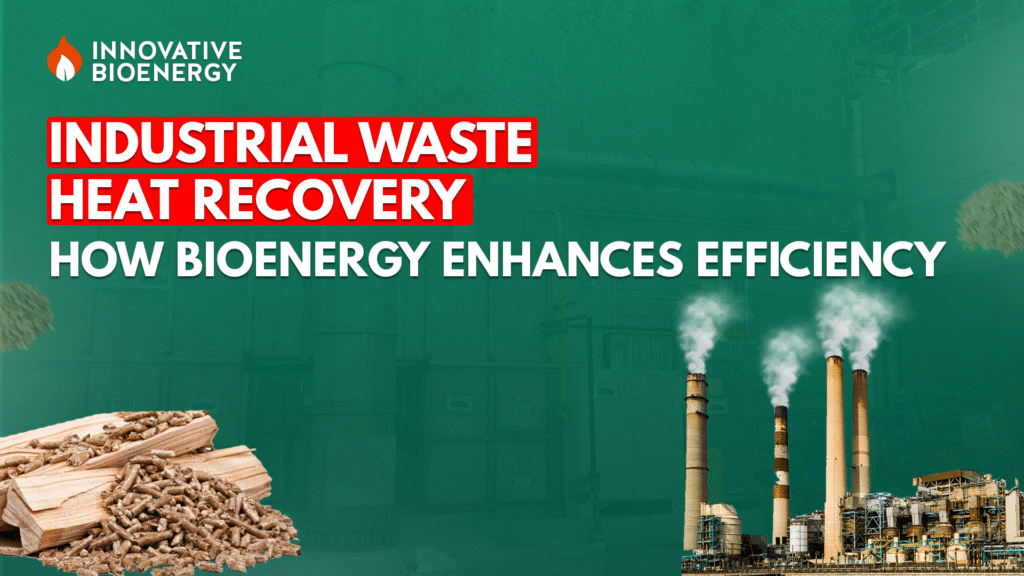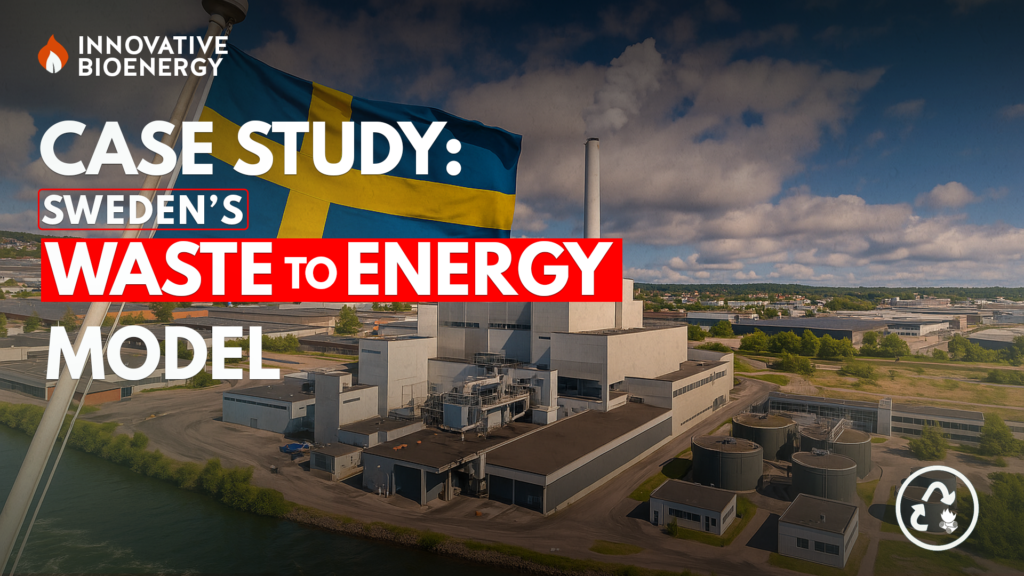Introduction
Industrial waste heat recovery (WHR) is a crucial strategy for improving energy efficiency, reducing operational costs, and lowering greenhouse gas emissions in manufacturing and processing industries. By capturing and reusing heat that typically escapes into the environment, businesses significantly enhance their sustainability.
At Innovative Bioenergy, we envision smarter, cleaner industrial systems powered by bioenergy technologies. Our wood pellets and briquettes, derived from agricultural and forestry residues, fuel efficient, low-emission systems that support long-term profitability and ESG compliance.
Integrating bioenergy with WHR systems transforms industrial processes into more sustainable, low-carbon operations without sacrificing performance or profitability. Learn more about how bioenergy supports corporate sustainability and ESG goals here.
Understanding Industrial Waste Heat Recovery
Industrial WHR captures excess thermal energy generated during processes like:
- Metal forging
- Chemical manufacturing
- Cement production
- Pulp and paper processing
Typically classified as low-grade waste heat, this energy can be effectively reused through advanced equipment such as:
- Heat exchangers
- Heat Recovery Steam Generators (HRSGs)
- Organic Rankine Cycle (ORC) units
Recovered energy can serve multiple purposes:
- Electricity generation (waste heat to power)
- Process heating
- Building heating
- Absorption chilling for cooling
According to the U.S. Department of Energy, waste heat recovery can reclaim 20–50% of lost industrial energy, making it a high-impact area for efficiency gains.
The Role of Bioenergy in Enhancing WHR
Bioenergy, derived from organic materials like agricultural residues, forestry by-products, and organic waste, significantly enhances WHR by:
- Providing renewable fuel sources, replacing fossil fuels, and cutting carbon emissions.
- Generating biothermal waste heat through processes such as anaerobic digestion and fermentation.
- Enabling combined heat and power (CHP) systems, capturing electricity and thermal energy simultaneously.
- Increasing flexibility through biofuel compatibility with existing WHR infrastructure.
The International Energy Agency highlights that bioenergy is the largest source of renewable heat in industry, offering scalable solutions for integrating sustainability with heat recovery.
Leading Technologies for Bioenergy-Enhanced WHR
1. Organic Rankine Cycle (ORC)
- Converts low-to-medium temperature waste heat into electricity. ORC systems powered by bioenergy achieve efficiencies up to 25%, beneficial for food and chemical industries.
2. Heat Recovery Steam Generators (HRSG)
- Capture high-temperature exhaust from biomass combustion or gasification, producing steam for turbines or industrial heating.
3. Anaerobic Digestion and Biogas Upgrading
- Transform organic waste into biogas, used for heating or upgraded to biomethane, while producing recoverable thermal energy.
4. Biomass Pretreatment Technologies
- Methods like torrefaction and pyrolysis enhance biomass quality, ensuring efficient combustion and maximizing WHR efficiency.
Benefits of Integrating Bioenergy with WHR
- Enhanced Energy Efficiency: Combined bioenergy-WHR systems can reach overall efficiencies of up to 90%.
- Reduced Operational Costs: Less reliance on fossil fuels and cheaper biomass resources significantly lower energy expenditures.
- Lower Carbon Emissions: Sustainable bioenergy combined with heat reuse substantially reduces greenhouse gases.
- Improved Equipment Longevity: Recycling heat reduces thermal stress, lowering maintenance requirements and extending equipment lifespan.
- Scalability and Flexibility: Systems adapt easily across various industrial applications and feedstock types, ensuring widespread applicability.
Real-World Examples and Case Studies
- Industrial Food Processing: Bioenergy-powered ORC systems in food industries demonstrate efficiency gains of up to 25% and cost savings on energy bills.
- Pulp and Paper Industry: Use of biomass-based HRSGs significantly reduces operational costs and carbon footprint.
Discover how Unilever is achieving ESG goals with renewable energy through bioenergy solutions in our detailed case study.
Key Statistics and Data
- Between 20% and 50% of industrial energy input is lost as waste heat.
- Up to 80% of low-level waste heat could be cost-effectively recovered in manufacturing processes.
- Recovering 80% of low-level waste heat in the U.S. could unlock over $50 billion per year in economic value.
- Industrial CHP systems involving WHR can achieve total energy efficiencies around 80%.
- As noted by the European Commission, optimizing energy use in industrial processes, including waste heat recovery, could yield €140 billion in annual savings.
Overcoming Challenges and Encouraging Adoption
Key Challenges:
- Feedstock variability and supply chain complexities may pose reliability risks.
- High upfront capital costs could slow adoption.
- Operational complexity demands trained personnel for optimal system management.
Recommended Policy Actions:
- Support pilot and demonstration projects.
- Implement carbon pricing and renewable energy incentives.
- Invest in research and development for advanced WHR and bioenergy integration technologies.
Conclusion
Integrating bioenergy with industrial waste heat recovery presents a transformative opportunity for industries aiming to enhance efficiency, reduce emissions, and lower energy costs. Leveraging renewable biomass through technologies like ORC and HRSG paves the way for sustainable, profitable operations.
At Innovative Bioenergy, we deliver tailored biomass solutions that align with industrial needs, support ESG goals, and transform waste heat into a resource, not a liability. For forward-looking industries, integrating industrial waste heat recovery with bioenergy is not a future consideration; it’s a present-day priority for profitability and sustainability.


